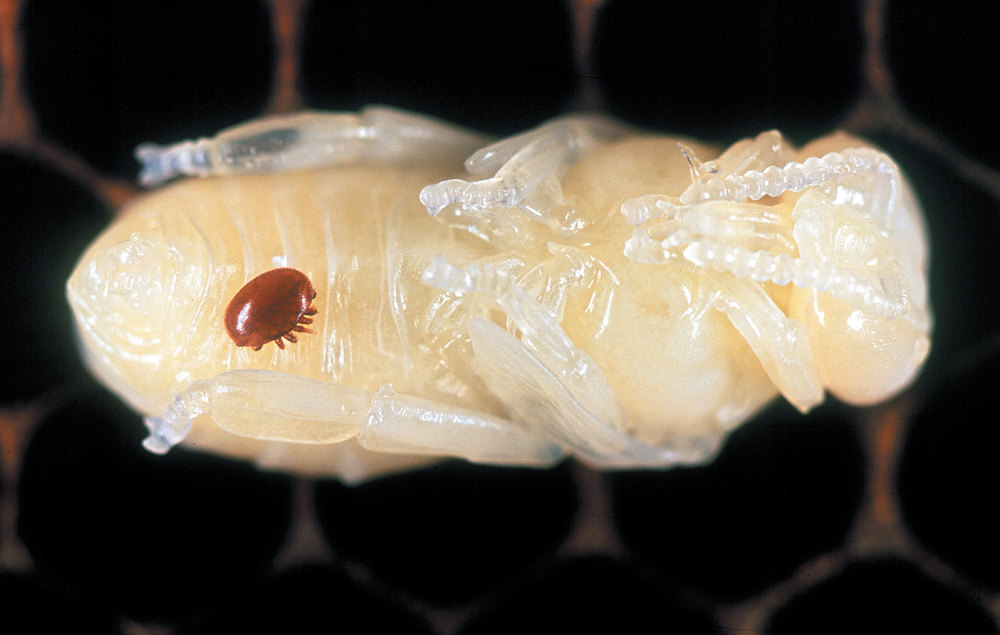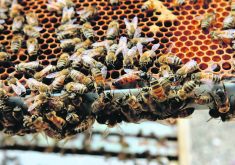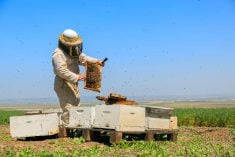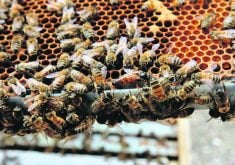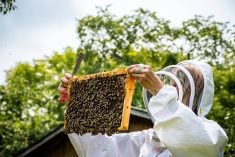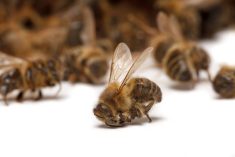Research at the University of Manitoba involves a promising and inexpensive control for varroa mites in honeybee colonies.
Professor Rob Currie, head of the school’s department of entomology, is exploring the use of carbon dioxide to help mitigate mite infestations. The elevator pitch behind the treatment is that varroa mites have a higher sensitivity to CO2 than honeybees, and exposure to high levels can kill the mites without harming the bees.
Currie and his team set out to test this hypothesis in an overwintering facility.
Read Also

Weekend warrior horses at risk
Horses need steady, rhythmic movement. Going from no activity to weekend bursts of exercise risks physical strain and injury.
Why it matters: Manitoba beekeepers have reported higher than normal mite counts in the last few years, leading to concerns that common chemical controls may no longer be working as well as they used to.
Varroa mites are small, oval-shaped parasites that infest honeybee colonies. The pests attach themselves to adult honeybees or their larvae, pierce the bee’s exoskeleton and feed on their hemolymph (blood). This weakens the bees and shortens their lifespans. Varroa mites also spread viruses that can infect the colony.
Varroa mites became a problem for beekeepers in the 1990s and were initially kept under control through chemical treatments, but the pests began to develop resistance.
“Apivar is basically the best treatment that we have right now,” said Derek Micholson, a crop production extension apiarist with Manitoba Agriculture.
Apivar has been around for more than 10 years and has held up much better than its predecessors. However, data suggests that its effectiveness is waning.
“Within the last couple of years, there have been more and more beekeepers that have been reporting that this product may not be working as well as it has in the past,” Micholson said. “We’ve started doing resistance testing [for Apivar], and in many of the tests, it still works very well, but in some of the tests, we’ve seen that the efficacy is quite low.”
The product can still be used as part of an overall integrated pest management strategy, he added. Using organic acids like formic acid or oxalic acid, for example, are preferred non-chemical means to control varroa mites.
Micholson expressed interested in whether CO2 can be added to the toolbox, and he’s looking forward to the results of Currie’s trials.
Those trials, which are in their fourth year, have seen ups and downs. In the first two years (2019-20 and 2020-21), CO2 levels were controlled by reducing ventilation without adding additional CO2. The first year provided solid results.
“We saw the colonies that came out of the treatment had kind of larger cluster sizes and reduced mite levels, and it looked quite good,” said Currie.
However, in the second year, mite levels were too low to gather useful data.
In the third year, researchers boosted CO2 levels by placing dry ice in the rooms and allowing it to sublimate.
“We were looking at figuring out how CO2 could affect things like mite mortality, spring mite levels and spring colony health, and we also wanted to look at how dose and duration of treatment affected those things,” Masters student Sara LaValley said during a March 7 presentation on the project.
The experiment was done in the overwintering building at the university. Four small rooms were set up with ventilation similar to a typical commercial overwintering building. One room was used as a control, and the other three were treated with CO2 by adding coolers filled with dry ice.
The experiment employed two different doses, either 20 or 40 kilograms per week, and two different durations, either two or four weeks.
In the fall, they measured overall colony health levels, virus levels and colony size. Over the winter, they monitored CO2 levels and bee and mite mortality. Come spring, they repeated the colony health measurements done in the fall. Unfortunately, overwinter conditions did not support good data collection.
“That was the disaster year for Manitoba, where the province had 57 per cent mortality in the colonies,” said Currie.
The research wasn’t spared. All but five of the 84 colonies didn’t survive the winter. There were also problems with leaky seals, largely a result of mice chewing through the plastic barriers. That caused CO2 levels to be lower than desired.
With all those problems, especially massive colony loss, little could be gleaned from the data.
In terms of mite mortality, it looked like the low-dose, low-duration treatment was most effective. And it appeared bee survival was also better under those conditions.
“There might be something to that,” said LaValley. “But with such a low number actually surviving, it’s impossible to say.”
Final year
The fourth year of the study is underway. Several steps were taken to address the shortcomings of the previous year, including treating half the hives with oxalic acid to improve the chances of colony survival. So far, initial data indicates that spring results may be more useful.
“I’m kind of anxiously awaiting to see the results this year and see what the bees look like when they come into the building,” Currie said.
The most beekeepers can hope for from this treatment is for it to become part of the overall strategy for controlling varroa mites, he added. The technique did not prevent that massive colony loss in its third year, and he said it’s clear CO2 won’t put an end to the varroa mite crisis.
“It’s not going to be the saviour of everything, but I think it does look very promising in terms of a very low-cost way of providing an additional measure for helping beekeepers keep varroa mites under control.”
Currie said the method might be ready for commercial use very soon.
“What we’re doing now is just trying to figure out what levels of CO2 are optimal to get the most mite kill without killing bees,” he said.
Good results this spring could help figure that out. But there are bureaucratic hurdles to get over first.
“Technically speaking, whenever you have any sort of chemical or other control measure you’re using as a way of controlling a pest, it has to be registered through PMRA [Pest Management Regulatory Agency],” said Currie.
“After we’ve dotted all the I’s and crossed all the T’s, that would probably put it in the realm of four or five years before it can be implemented.”


